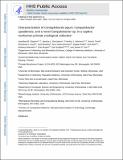Characterization of Campylobacter jejuni, Campylobacter upsaliensis, and a novel Campylobacter sp. in a captive non‐human primate zoological collection
Author(s)
Shen, Zeli; Mannion, Anthony; Bryant, Erin; Fox, James G.
DownloadAccepted version (737.2Kb)
Open Access Policy
Open Access Policy
Creative Commons Attribution-Noncommercial-Share Alike
Terms of use
Metadata
Show full item recordAbstract
© 2018 John Wiley & Sons A/S. Published by John Wiley & Sons Ltd Background: The aim of this study was to longitudinally investigate the prevalence and characterization of Campylobacter spp. from non-human primates primate (NHP) with a history of endemic diarrhea housed at Como Park Zoo. Methods: Fecal samples from 33 symptom-free NHP belonging to eight different species were collected weekly for 9 weeks. Species-level characterization and phylogenetic analysis of isolates included biochemical testing and 16S rRNA sequencing. Results: Campylobacter spp. were isolated from the feces of 42% (14/33) of the primates. Three Campylobacter spp. (C upsaliensis, C jejuni, and novel Campylobacter sp.) were identified from three NHP species. A possible positive host Campylobacter species-specificity was observed. However, no statistical association was observed between the isolation of Campylobacter spp. and age and sex of the animal. Conclusions: The study revealed the value of conducting repeated fecal sampling to establish the overall prevalence of Campylobacter in zoo-maintained NHP; it also importantly identifies a novel Campylobacter sp. isolated from white-faced saki monkeys.
Date issued
2018-12Department
Massachusetts Institute of Technology. Division of Comparative Medicine; Massachusetts Institute of Technology. Department of Biological EngineeringJournal
Journal of medical primatology
Publisher
Wiley
Citation
Clayton, Jonathan B., et al., "Characterization of Campylobacter jejuni, Campylobacter upsaliensis, and a novel Campylobacter sp. in a captive non‐human primate zoological collection." Journal of medical primatology 48, 2 (December 2018): p. 114-22 doi 10.1111/JMP.12393 ©2018 Author(s)
Version: Author's final manuscript
ISSN
1600-0684
0047-2565